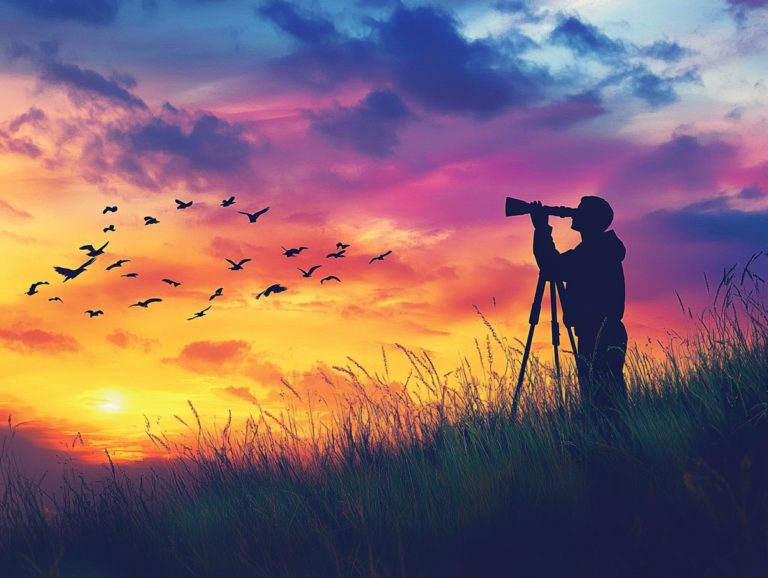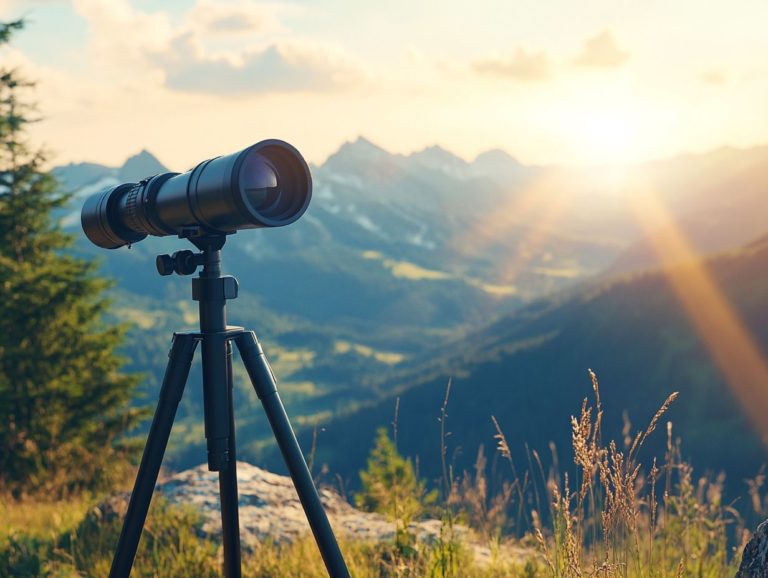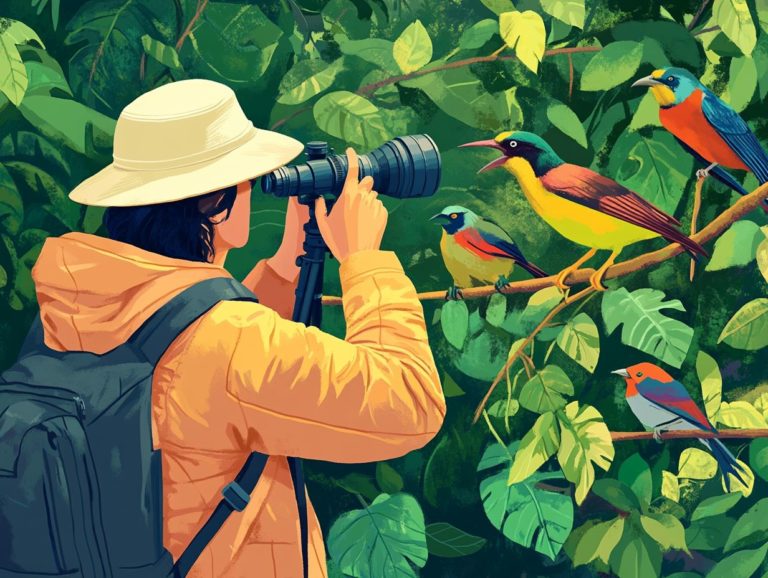Understanding the Technology Behind Spotting Scopes
Spotting scopes are indispensable tools for birdwatching, hunting, and nature observation, providing you with a closer look at distant subjects with impressive clarity.
Get ready to explore the amazing world of spotting scopes! This guide will help you understand the various types of scopes, assisting you in choosing between straight and angled models, as well as zoom and fixed magnification options.
Key features to consider include objective lens size and eye relief, along with helpful tips for optimal use and maintenance. Whether you’re just starting out or a seasoned enthusiast, this guide is designed to elevate your spotting scope experience.
Contents
- Key Takeaways:
- Types of Spotting Scopes
- Key Features to Consider
- Using a Spotting Scope
- Caring for Your Spotting Scope
- Frequently Asked Questions
- What is the purpose of a spotting scope?
- What are the key components of a spotting scope?
- How does the objective lens affect the performance of a spotting scope?
- What is the role of the eyepiece in a spotting scope?
- What is the purpose of the prism in a spotting scope?
- How can I choose the right spotting scope for my needs?
Key Takeaways:

- A spotting scope is an optical device that allows long-distance viewing, perfect for nature lovers.
- When choosing a scope, consider its type, magnification, lens size, and eye relief for the best experience.
- Proper setup and maintenance are essential for clear views and the longevity of your scope.
What is a Spotting Scope?
A spotting scope is an exceptional optical instrument made for careful observation of distant subjects, making it a critical companion for your birdwatching, wildlife observation, and even stargazing adventures. With top-notch optics, these devices offer impressive magnifications, allowing you to savor intricate details of both wildlife and landscapes.
The lightweight design and versatility make spotting scopes a favorite among outdoor enthusiasts eager to immerse themselves in nature s beauty.
Typically built with robust construction and premium materials, these instruments guarantee durability in various weather conditions. Whether you have it securely mounted on a tripod in the wilderness or are holding it steady while navigating a hike, its portability makes transport easy.
Spotting scopes enhance your experiences, whether you re a birdwatcher or a hunter, as their clarity reveals color patterns and movements that often escape the naked eye. The importance of high-quality optics cannot be overstated; they improve light transmission, contrast, and resolution, helping you see subtle details and ensuring that every moment spent outdoors is enriching.
Types of Spotting Scopes
You ll find an impressive array of spotting scopes on the market, each tailored with distinct features to meet your specific observational needs. Whether you prefer a straight construction or an angled eyepiece design, there s a scope for you, enhancing your field of view.
If versatility is what you seek, consider a spotting scope with zoom magnification, allowing you to effortlessly adjust your view on the fly. Alternatively, a fixed magnification scope offers a stable and consistent experience, perfect for focused observations.
By grasping the nuances of these options, you can confidently choose the ideal spotting scope for your pursuits, be it birdwatching, hunting, or capturing the beauty of nature through photography and digiscoping equipment.
Straight vs Angled
When deciding between straight and angled spotting scopes, understanding how they’re constructed and used is vital for enhancing your viewing experiences, whether you re bird watching or hunting.
Straight construction scopes offer a direct line of sight, making them ideal for quick observations and tracking moving subjects.
In contrast, angled eyepieces allow for comfortable viewing at higher angles, which is especially handy in nature observation where tripods are common.
The ergonomic benefits of each design can impact your comfort during long observation sessions. With an angled scope, you can maintain a relaxed posture when scanning elevated terrains, reducing neck strain.
Setup is a key aspect that enhances your experience. Straight scopes align quickly with your target, while angled designs simplify adjustments in tricky viewing situations. Together, these features broaden your field of view, allowing you to immerse yourself in the beauty of nature without discomfort or distraction.
Ultimately, choosing between the two designs is not just about personal preference; it s crucial for your enjoyment and engagement in the great outdoors, especially for hunting optics.
Zoom vs Fixed Magnification
Choosing between zoom and fixed magnification in spotting scopes can greatly shape your viewing experience, especially during activities like bird watching and animal observation.
Zoom magnification provides flexibility, allowing you to adjust your view based on the distance and size of your subject, which is perfect for varying light conditions and different observation scenarios.
On the other hand, fixed magnification offers clarity and simplicity, usually providing a more stable image with less distortion during focus adjustments.
Knowing the magnification range is essential, especially when you have specific observation needs. For example, on a peaceful morning in the woods, using fixed magnification enhances details, letting you appreciate fine feathers or intricate patterns without the distraction of zoom adjustments. This is beneficial for binoculars usage in observing birds.
In lively environments like a wildlife reserve, where animals may be on the move, the adaptability of zoom helps you quickly shift focus, capturing fleeting moments without losing track of the action.
Each type offers unique advantages, and understanding these differences can elevate your overall experience.
Key Features to Consider

You ll want to consider some key features to ensure you get the best spotting scope for your adventures. Focus on the objective lens size, eye relief, and the scope’s waterproof design, which is essential for wildlife photography.
The objective lens size plays a crucial role in light-gathering capabilities, enhancing visibility in different light conditions. Adequate eye relief is vital for comfort during lengthy viewing sessions, allowing you to observe distant wildlife or breathtaking landscapes without strain.
Objective Lens Size
The size of a spotting scope’s objective lens is critical for its performance, especially in varying light conditions. It directly affects the brightness and clarity of the images you observe.
A larger objective lens captures more light, vital for spotting activities in low-light situations, such as bird watching at dawn or dusk. You’ll want high-quality optics to capture those breathtaking moments in nature!
If you often engage in wildlife observation or stargazing at night, a scope with a larger lens is a wise choice. Conversely, if you mainly use your gear in bright daylight, a smaller lens might be sufficient, balancing portability and clarity.
Assess your specific needs: if maximizing detail in challenging lighting is important, investing in a larger objective lens will be invaluable. Selecting the right size not only enhances visibility but also elevates your entire observation experience.
Eye Relief
Eye relief is a key feature in spotting scopes that defines how far your eye can be from the eyepiece while still seeing a full field of view. This aspect greatly improves your comfort during long viewing times, whether you’re birdwatching or hunting.
If you wear glasses, having enough eye relief is essential. It allows you to enjoy your spotting scope without losing visibility or clarity.
For instance, when you re stargazing or practicing wildlife photography, generous eye relief is a game-changer. It reduces eye strain, letting you observe for extended periods without discomfort, especially when using a tripod that needs precise setup.
In activities like competitive shooting or long-distance observing, being able to adjust your eye position without losing sight of your target can greatly impact your performance. Knowing about eye relief not only enhances usability but also improves your overall experience with the scope.
Prism Type
The type of prism you select for your spotting scope is crucial for the quality of your lenses and image performance. Common choices include Porro prisms and BAK-4 prisms, each with distinct benefits.
BAK-4 prisms shine in light transmission and image clarity, making them ideal for birdwatching and nature observation, where every detail matters.
Understanding these differences is important to find the right equipment that suits your needs. Porro prisms, on the other hand, often provide a wider field of view, useful for tracking moving subjects like wildlife in action.
Think about where you’ll mostly be observing. If you’re often in shaded areas or out during dawn or dusk, going for a BAK-4 prism will likely enhance your experience, ensuring vibrant visuals and a clearer perspective on the subjects you love.
Using a Spotting Scope
To use your spotting scope effectively, you need to know the nuances of proper setup and adjustment techniques. This knowledge helps you enjoy every moment of your viewing, whether you re looking at wildlife or breathtaking landscapes.
Start by placing the scope on a sturdy tripod; this is a crucial first step. Then, adjust the focus and magnification settings to fit your preferences. Each adjustment is vital for achieving optimal viewing conditions, especially in environments where light conditions change.
Proper Setup and Adjustment

Setting up and adjusting your spotting scope properly can greatly enhance your viewing experience. Start by securing the scope to a stable tripod; this foundation is essential for steady observations.
Make sure the scope is level and aligned with your target area, as even slight misalignments can hinder focus adjustments and reduce your enjoyment during birdwatching or hunting outings.
Once you’ve chosen the right tripod, securely attach the scope to prevent unwanted movement. After it’s secure, take a moment to adjust the angles for optimal viewing.
Adjusting the focus is also important, especially when you re looking at subjects at different distances. Simply turning the focus knob will help achieve the sharp clarity you want.
For the best results, especially on windy days, consider adding weight to the tripod legs for better stability. Cleaning the lenses regularly keeps your images clear and unobstructed.
Finally, check your settings before each observation. This simple step allows for a seamless experience as you capture the stunning beauty of nature.
Tips for Optimal Viewing
Achieving optimal viewing with a spotting scope involves several strategies that enhance clarity and detail.
Consider factors such as the time of day, the positioning of the scope, and those small changes to focus that can dramatically improve visibility. This is important whether you’re tracking birds in flight or observing wildlife in their natural habitats.
To maximize your experience, tweak your setup according to the sunlight. For instance, early mornings and late afternoons offer softer, more favorable light for observation.
Keeping your scope steady with a tripod can make a world of difference. It allows you to maintain focus on moving subjects and reduces the strain that comes from hand-held views.
Techniques like using a neutral density filter a filter that reduces brightness without affecting color can also help decrease glare and enhance clarity, especially in bright conditions.
By mastering these adjustments, you ll greatly enhance your chances of spotting amazing wildlife and appreciating the intricate details of the natural world.
Caring for Your Spotting Scope
Caring for your spotting scope is vital to preserving its performance and extending its lifespan. This includes regular cleaning and maintenance practices that safeguard its quality optics.
Keeping the lenses free from dirt, moisture, and fingerprints ensures clear visibility and reliable performance during activities like birdwatching or hunting, where precision matters.
These steps not only enhance your experience but also maximize the longevity of your investment. Don t wait until your scope is damaged take action now to protect your investment!
Cleaning and Maintenance
Regularly cleaning and maintaining your spotting scope is essential for preserving its optical performance. This is especially true for waterproof models that require extra care to prevent internal fogging and moisture build-up.
To effectively clean your optics, use a microfiber cloth designed for lenses, paired with a gentle lens cleaner to avoid scratches.
Techniques like using compressed air can help you remove dust particles without direct contact, further protecting those delicate surfaces.
Perform maintenance after every few uses or immediately after exposing your scope to harsh environments. This diligence will keep your scope free from grime, dirt, and other environmental hazards.
Proper storage in a padded case will shield your equipment from accidental impacts and environmental damage, extending its lifespan and reliability.
By taking these steps, you ensure that your spotting scope remains a trusted companion on all your explorations.
Frequently Asked Questions
What is the purpose of a spotting scope?

A spotting scope is a type of telescope specifically designed for terrestrial use. Its purpose is to provide magnified views of distant objects, making them appear closer and clearer. This makes them ideal for activities such as birdwatching, nature observation, and target shooting.
What are the key components of a spotting scope?
The main parts of a spotting scope include the objective lens, eyepiece, focusing mechanism, and prism. These components work together to collect and magnify light, adjust the focus, and correct the image, resulting in a clear and detailed view of distant objects.
How does the objective lens affect the performance of a spotting scope?
The objective lens is the most important part of a spotting scope as it determines the amount of light that enters the scope. The larger the objective lens, the more light it can gather, resulting in a brighter and clearer image.
This is why spotting scopes with larger objective lenses tend to have better performance and higher prices.
What is the role of the eyepiece in a spotting scope?
The eyepiece magnifies the image collected by the objective lens, which is the main lens that gathers light to create an image. It is often interchangeable, allowing users to switch between different zoom options to suit their needs.
The eyepiece quality directly affects the spotting scope’s performance.
What is the purpose of the prism in a spotting scope?
The prism corrects the image, making it appear upright and correctly oriented. Without a prism, the image would be upside down and inverted, which can be challenging for activities like birdwatching.
There are two types of prisms used in spotting scopes: Porro prisms and roof prisms.
How can I choose the right spotting scope for my needs?
When selecting a spotting scope, consider factors such as its intended use, magnification power, objective lens size, and overall build quality. Also, dive into reviews and compare models to discover the perfect scope for your adventures!






